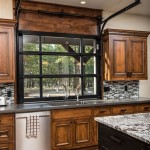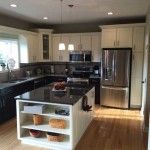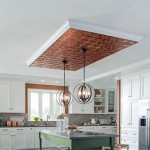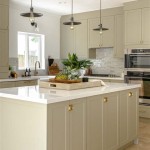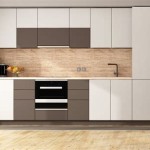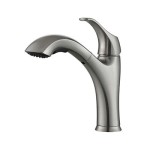Kitchens With Shelves Instead of Upper Cabinets: A Comprehensive Guide
The design of kitchen spaces is constantly evolving, reflecting changes in lifestyle, technological advancements, and aesthetic preferences. One discernible shift in modern kitchen design is the growing popularity of open shelving as a replacement for traditional upper cabinets. This transition is not merely a stylistic choice; it's a fundamental alteration affecting functionality, visual appeal, and the overall user experience within the kitchen environment.
The decision to opt for shelves over upper cabinets involves a careful evaluation of multiple factors. Considerations encompass storage needs, aesthetic goals, maintenance requirements, and the specific architectural characteristics of the kitchen. While open shelving presents numerous advantages, it also introduces unique challenges that must be addressed to ensure a practical and visually harmonious kitchen space.
This article will explore the diverse aspects of kitchens designed with open shelving, offering insights into the benefits, drawbacks, design considerations, and practical tips for successfully integrating this design element. The aim is to provide a comprehensive understanding that enables informed decisions about whether this design trend aligns with specific needs and preferences.
The Allure of Open Shelving: Benefits and Advantages
Open shelving offers several compelling advantages that contribute to its rising popularity in kitchen design. These benefits extend beyond mere aesthetics, impacting the functionality and atmosphere of the kitchen space.
One of the primary advantages is the enhanced sense of openness and visual spaciousness created by the absence of bulky upper cabinets. This is particularly beneficial in smaller kitchens, where traditional cabinets can make the room feel cramped and enclosed. By removing the visual barrier of upper cabinets, open shelving allows for more natural light to penetrate the space, creating a brighter and more inviting atmosphere.
Accessibility is another key benefit. Open shelves provide immediate and unobstructed access to frequently used items, such as dishes, glasses, and cooking utensils. This eliminates the need to rummage through cabinets, saving time and effort during meal preparation. The visual display also serves as a constant reminder of available items, reducing the likelihood of forgotten ingredients or unused kitchenware.
Aesthetic appeal is undoubtedly a significant factor driving the trend toward open shelving. It provides an opportunity to showcase carefully curated collections of dishware, glassware, and decorative objects, transforming the kitchen into a personalized and visually engaging space. The ability to style and rearrange shelves allows for constant updates to the kitchen's aesthetic, reflecting changing tastes or seasonal themes. This element of dynamic expression is not typically achieved with traditional cabinet systems.
Cost-effectiveness can also be a consideration. In some cases, installing open shelving can be a more budget-friendly option than purchasing and installing custom or high-end upper cabinets. The savings can be significant, particularly when opting for simpler shelving materials and designs.
Navigating the Challenges: Drawbacks and Considerations
While open shelving offers numerous benefits, it is crucial to acknowledge and address the potential drawbacks associated with this design choice. These challenges primarily relate to maintenance, organization, and the potential for visual clutter.
Dust accumulation is perhaps the most frequently cited concern with open shelving. Unlike items stored behind closed cabinet doors, items on open shelves are exposed to airborne dust and grime. This necessitates more frequent cleaning and dusting to maintain a presentable and hygienic kitchen environment. The frequency of cleaning will depend on factors such as the proximity to cooking areas, the level of ventilation, and the surrounding environment.
Organization is paramount when implementing open shelving. Unlike the concealed storage offered by cabinets, open shelves require a degree of visual order and coordination. Items displayed on shelves are constantly visible, meaning that cluttered or disorganized shelves can detract from the overall aesthetic of the kitchen. Maintaining a cohesive and visually appealing arrangement requires careful planning and a degree of discipline in terms of placement and styling.
The potential for visual clutter is a significant consideration. Open shelving can easily become overwhelmed with too many items, creating a chaotic and visually distracting environment. The key is to selectively curate the items displayed on shelves, prioritizing frequently used and aesthetically pleasing objects. Less visually appealing or infrequently used items should be relegated to closed storage solutions.
Privacy and concealment are also affected by open shelving. Cabinets provide a level of privacy and concealment that open shelves cannot replicate. Items stored on open shelves are perpetually on display, which may not be desirable for all individuals or in all kitchen contexts. Carefully consider the types of items planned for storage and whether their exposure aligns with personal preferences and aesthetic goals.
Design and Implementation: Key Considerations for Open Shelving
Successfully integrating open shelving into a kitchen design requires careful planning and attention to detail. Several key considerations should be addressed to ensure a functional, aesthetically pleasing, and practical kitchen space.
Shelf Material Selection is crucial. The choice of shelving material plays a significant role in the overall aesthetic, durability, and maintenance requirements of the open shelving system. Common materials include wood, metal, glass, and engineered composites. Wood offers a warm and natural aesthetic, but requires regular sealing and maintenance to prevent moisture damage. Metal provides a sleek and modern look, but can be prone to scratching. Glass shelves create a light and airy feel, but require frequent cleaning to remove fingerprints and smudges. Consider the overall design style of the kitchen and the intended use of the shelves when selecting the appropriate material.
Shelf Placement and Spacing are important factors. The placement of shelves should be carefully considered in relation to the overall kitchen layout and workflow. Shelves should be positioned within easy reach of frequently used work areas, such as the stovetop, sink, and countertop prep areas. The spacing between shelves should be sufficient to accommodate the intended items, while also maintaining a visually balanced arrangement. Consider varying the spacing between shelves to accommodate items of different sizes and shapes.
Lighting is integral to open shelving design. Adequate lighting is essential for both functional and aesthetic purposes. Under-cabinet lighting can be installed above the shelves to illuminate the displayed items and provide task lighting for the countertop below. Spotlights or track lighting can be used to highlight specific items or create a dramatic effect. Consider the color temperature of the lighting to complement the overall kitchen design and create the desired ambiance.
Styling and Arrangement are key to visual appeal. The way in which items are styled and arranged on open shelves significantly impacts the overall aesthetic of the kitchen. Consider using a combination of vertical and horizontal arrangements to create visual interest. Group items by color, shape, or material to create a cohesive and organized look. Incorporate decorative objects, such as plants, artwork, or cookbooks, to add personality and visual interest. Regularly edit and rearrange the shelves to maintain a fresh and updated look.
Storage Solutions on Open Shelves require careful consideration. While showcasing frequently used items is a primary function of open shelving, incorporating storage solutions can enhance organization and minimize clutter. Baskets and bins can be used to contain smaller items and create a more unified look. Canisters and jars can be used to store dry goods, while also adding a decorative element. Consider using tiered stands or risers to maximize vertical space and create visual interest.
Integration with Other Storage Solutions is also part of the design. Open shelving should be integrated seamlessly with other storage solutions in the kitchen, such as lower cabinets, drawers, and pantries. Use closed storage to conceal less visually appealing or infrequently used items, reserving open shelves for frequently used and aesthetically pleasing objects. Consider the overall flow and functionality of the kitchen when planning the distribution of storage space.
Consider the Kitchen Style when designing open shelving. The design of the open shelving should complement the overall style of the kitchen. For example, in a rustic kitchen, wooden shelves with a distressed finish would be appropriate. In a modern kitchen, sleek metal shelves with a minimalist design would be a better fit. Consider the materials, colors, and finishes used throughout the kitchen when designing the open shelving system.
Maintenance and Cleaning Routine are very important. Open shelves require regular cleaning and maintenance to prevent dust accumulation and maintain a presentable appearance. Establish a routine for dusting and cleaning the shelves, as well as the items displayed on them. Consider using microfiber cloths or electrostatic dusters to effectively remove dust without scratching or damaging the shelving material. Regularly inspect shelves for signs of wear and tear, and address any issues promptly. Items on shelves should also be cleaned regularly to prevent the buildup of dust and grime.

Why I Combined Open Shelves And Cabinets In My Kitchen Remodel

Open Shelving Vs Cabinets Which Is Better Laurysen Kitchen Design

Open Shelving Vs Upper Cabinets In Kitchen Pros And Cons

30 Beautiful Kitchens With Floating Shelves Ideas And Tips

30 Beautiful Kitchens With Floating Shelves Ideas And Tips

11 Open Shelving Kitchen Ideas Benefits And Alternatives

Open Shelving Vs Upper Cabinets In Kitchen Pros And Cons

Open Kitchen Shelving Ideas From Real Renovations

Should You Use Open Shelves In The Kitchen

Kitchen Open Shelving The Best Inspiration Tips Inspired Room

